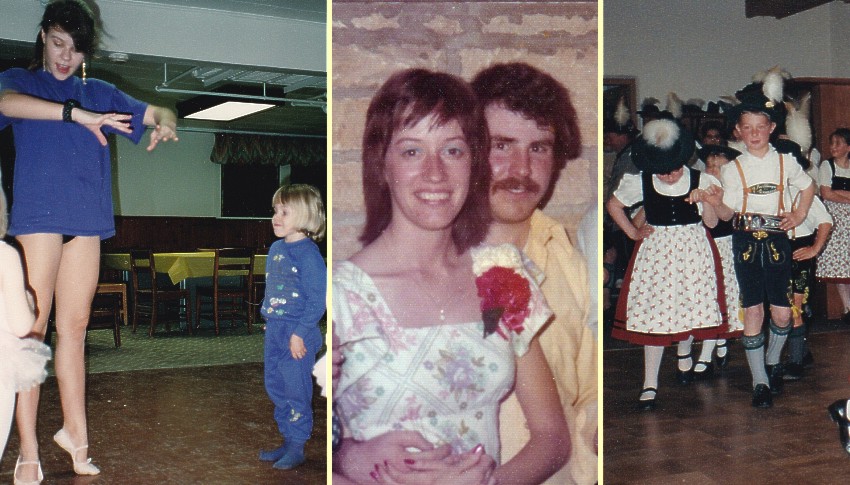Kansas Snapshots by Gloria Freeland - January 15, 2021
The joy of dancing
A few evenings back, our local PBS station had a "filler" segment that featured Mercia Tapping. She explained how dancing helped her
heal after her own journey through breast cancer had followed quickly on the heels of her husband's death.
While I can't say I have thought of dance as an antidote to grief, I’ll confess to having had an interest in it since I was a
little girl. I remember stretching up on my toes and twirling around our living room pretending to be a ballerina, something I am
sure many youngsters have tried. Daughter Mariya flirted with it briefly, attending a couple of classes when she was about 4.
I also tried to waltz or polka to some of the tunes while our family watched "The Lawrence Welk Show" on Saturday evenings at home.
When we lived in Winfield, Kansas, I attended a ballroom dancing class. I don't recall much from that eighth-grade class, but I do
remember how our instructor insisted that we speak to each other politely, that the girls wear gloves and that the boys "escort" us
to our parents' waiting cars at the end of each session.
High school dances were a different matter. Most of the boys stood on one side of the room and the girls stood on the other side
with only a few souls brave enough to actually dance. Nothing had changed by our 25th reunion. We called ourselves "the class that
didn't dance," so while the DJ exhorted people to get out on the floor, we sat at tables and talked.
I did attend two proms, but those experiences could only be described as "different." My senior year, I went without a date, and
my junior year - I know you are going to laugh at this as husband Art always does - my date was a boy whose religion prevented him
from dancing!
College was also different, but this time in a good way. While I attended several spring formals hosted by our residence hall and
occasionally went to clubs that had dance floors, things took off after friend Tom introduced sister Gaila and me to his Latino
friends from Bolivia, Venezuela, Puerto Rico and other "south-of-the-border" countries. I had truly joyous times dancing with my
new Latino friends. It seemed like every weekend we'd end up crammed into someone's small basement apartment dancing our hearts
out until dawn. It didn't matter whether there was an equal number of men and women because we could always dance together in one
large circle.
But dancing seems to have pretty much disappeared from the American scene. It is a tad ironic that the television show, "Dancing
With The Stars," is so popular that references in print often only use the letters DWTS, yet few venues have dance floors.
I did dance a bit last spring, during a once-a-week-for-six-weeks Zumba class via the teleconferencing software Zoom. Gaila had
invited me to join her and some of her friends in La Paz, Bolivia. I jumped at the chance. In the late 1990s, Colombian dancer and
choreographer Alberto "Beto" Pérez created these exercise classes that include various Latin American dance styles, such as salsa,
reggae, merengue, cumbia, samba, flamenco and tango. An in-person class would have been better, but I had to be satisfied watching
the instructor on the screen. Sadly, while I participated as much as I could, I found that 40 years hadn’t been kind to my
out-of-shape body. I joined without video because, as I told Gaila, "I don't want everyone to see me flailing around!"
Then, last Saturday night, Art was doing one last run through the channels before we were going to retire. He happened upon the
2005 movie, "Marilyn Hotchkiss' Ballroom Dancing and Charm School." It was just quirky and engaging enough and included enough
actors we knew that we were pulled in. We watched the whole thing - even though it ended well past our usual bedtime.
It was based on a 1990 short film of the same name, with fragments of the original appearing as flashbacks. The story centers on
grieving baker Frank Keane who is finding it hard to move on after his wife's suicide. Frank happens upon a car accident involving
Steve Mills, who has suffered serious injuries. Steve was on his way to a ballroom dancing class to meet a childhood friend and
asks Frank to go in his place, which Frank reluctantly agrees to do. The story moves back and forth through scenes from Steve's
childhood, the accident and Frank's interactions with the people at the dance class.
Frank discovers he has a natural talent for dance, but, just as with Mercia Tapping, he also finds it gives him a new outlook on
life.
Mary Steenburgen plays the "substitute" dance instructor Marienne Hotchkiss. She is substituting because the regular instructor,
her mother Marilyn, is dead - and has been for some time.
As I watched her and the clips of Marilyn from the 1990 film, I could almost envision the woman who taught the ballroom dancing
class I attended. Marilyn, Marienne and my instructor were always poised, very measured and crisp in their instructions, and
oh-so-proper - even when moving to some of the more sensual dances.
Dance therapists say dance increases muscular strength, coordination and mobility, and it can be used for stress reduction and mood
management. But I like Marienne's "take" on dancing better:
Dancing is a very powerful drug, ... If embraced judiciously, it can exorcize demons, access deep-seated emotions and color your
life in joyous shades of brilliant magenta that you never knew existed. ...
